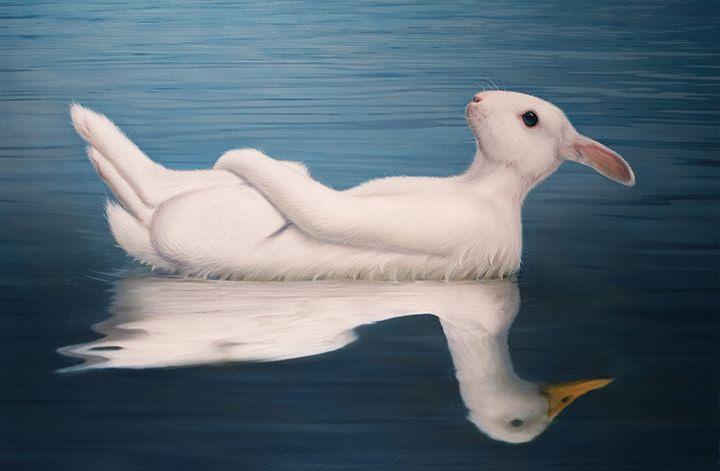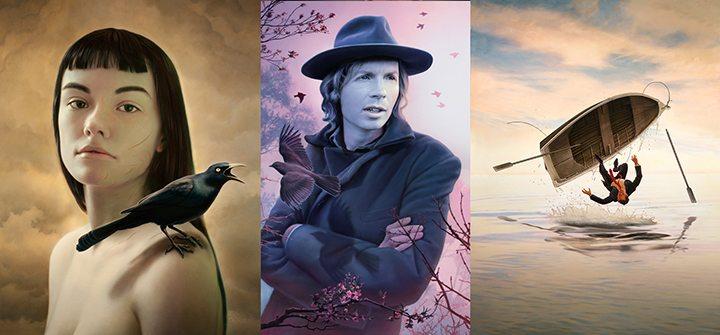The Q&A: Tim O'Brien
Q: What are some of your favorite things about living and working in New York?
A: Originally from North Haven, Connecticut, I moved to Brooklyn and in with my then girlfriend/now wife, Scholastic Creative Director Elizabeth Parisi, in the early 90’s when Brooklyn was still a city in transition. Park Slope was beginning to be gentrified and when we felt we were priced out in ’96, we bought a large Victorian home in another neighborhood in transition, Ditmas Park. We’ve been fortunate to be ahead of the real estate market all this time. Brooklyn is a worldwide destination for creative people.
Q: Do you keep a sketchbook? What is the balance between the art you create on paper versus in the computer?
A: I keep a sketchbook but work in it sporadically. I go months without touching it then fill it up in a weekend. All my thinking is done on paper and then most finals are figured out on the computer and then I paint the finals traditionally. A few of my finals are digital, but that is rare.
 Duck/Pond for Nautilus Magazine, AD Len Small
Duck/Pond for Nautilus Magazine, AD Len Small
Q: What do you like best about your workspace?
A: I would say the only thing I like about my workspace is the commute is short (3rd floor of my house.) I do have an entire floor and some additional work space on the second floor and in the basement for spraying and airbrush. I guess I took over the house.
Q: Do you think it needs improvement, if so, what would you change?
A: The studio is a mess but I know were everything is. I need a dumpster. I see other artists showing their studios and I marvel at the order of things. My friends are all more organized than I appear to be, but this studio works well. Despite the fact that I’m always working, it rarely gets worse. That’s something, right?
Q: What is the most important item in your studio?
A: I guess I’d be a liar if I didn’t say my computer. I started illustrating as a professional in 1986. In those early years sketches were done on half tone paper, mounted and sent overnight to clients. Research was done at book stores and the New York Public Library. Changes on finals were serious business and the computer is such a huge gift to an artist in comparison to how I started. Research, communication, design, social networking archiving and procrastination all are done on the computer.
Q: What is your favorite part of the creative process?
Q: That depends on the project. In most cases doing the final painting is the fun part, but sometimes a project allows for some real creativity in the sketch stage and it is in that phase that I really enjoy the process of image making. Painting is like performing a song but sketches are were you write the music.
Q: What was the strangest or most unusual assignment you’ve taken? What did you learn from the experience?
A: In the beginning of one’s career, ever job is unusual and this question makes me think back to the ‘fish-out-of-water’ feeling I had in those early years. Jobs were all learning experiences and I think I’ve figured most of it out by now. One early assignment was for an overbearing AD from Ballentine Books. I visited his office and he literally threw two manuscripts at me asking for sketches for both covers. I did both and he killed one on the spot, asking me to focus on the first manuscript. He then offered his idea. It was a bad one and I listened to him and did the sketch as he wanted it. When I returned he hated it and killed the job. It was crushing and I thought it might be the end.
I did vow that day to always show the AD how something could work if done a different way and I also learned to turn down assignments that are not right for my skill-set. Learning to turn down work takes some elegance and courage but I think ADs appreciate the honesty. They do come back.
 Obama and Reagan for TIME, Design
Director, D.W. Pine
Obama and Reagan for TIME, Design
Director, D.W. Pine
Q: What was your favorite book as a child?
A: James and the Giant Peach.
Q: What is the best book you’ve recently read?
Fiction: TransAtlantic by Colum McCann
Non Fiction: Who I Am: A Memoir by Pete Townshend
Q: If you had to choose one medium to work in for an entire year, eliminating all others, what medium would you choose?
A: I like to draw in pen and ink and envy artists who can get many images out per year because their technique is just drawing. I’d love to be able to work like that…then I see a big oil painting and it takes my breath away and I then think I’d like to just paint for one year without being an illustrator. Just me, a large panel and a sponsor.
Q: What are some of your favorite places/books/blogs/websites for inspiration?
A: I actually used to look around all the time but I find myself looking around less these days. I have an immense library of books that I look at on occasion. I could look at different artists to see what they’re doing, but I find that mentally confusing. I try to stay within my aesthetic and visual ideas and other artists’ work slips in anyway.
I am a huge fan of many artists and enjoy seeing their work but I don’t marinate in it. Still, I admire the ideas or Mark Tansey, the elegance of Eric Fortune’s work, the sexiness of Jonathan Viner’s, the fluid line of Wesley Allsbrook drawing, the versatility of Zohar Lazar,…I could go on all day.

Left to right: The Bond (Unpublished); Beck, Morning Phase, for
Rolling Stone, AD Joe Hutchinson; The Boat (Unpublished).
Q: What was the painting or drawing or film that most affected your approach to art [the Thunderbolt]?
A: Figuring out how a born realist could use realism was not easy. In my junior year I spent many hours in the school library pouring over books and annuals such as European Illustration, The Society of Illustrator Annuals and many others. Realists held few clues for me but I could see that the clever thinking from artist such as Brad Holland and Guy Billout would translate well into more real images. There were many early thunderbolts but an important one was to think on paper and not by looking at reference.
Q: If you could be anywhere but where you are now, where would that be?
A: If anywhere is a physical place, I’d like to be in a warmer climate, out for a run. If anywhere is a place in time, I like where I am just fine.
Q: Where do you teach—and what do you like best about teaching?
A: I teach at the University of the Arts in Philadelphia and Pratt Institute in Brooklyn. Teaching reinforces what I believe in but challenges it too. Teaching keeps me sharp and at it’s best, puts me in touch with young talent that go on to have important careers as illustrators and ADs.
Q: What advice would you give a young artist about applying to an art school or college?
A: Assuming they are heading to a college to be an illustrator, there are many great programs out there. Your college experience is the sum of great instructors and good fellow students and the living and working situation has to be comfortable.
Go to a program where the department is well funded, where there are some well-known, working illustrators among the faculty, and where the student residences are comfortable and close to the school.
Q: What would be your last supper?
A: 12 oysters, an aged, prime steak, a wedge salad, a good cabernet followed by some Kentucky bourbon. Other than that, I really haven’t given it any thought.
 Rabbit Duck for Nautilus Magazine, AD Len Small
Rabbit Duck for Nautilus Magazine, AD Len Small
Tim O’Brien, born in New Haven, Connecticut, has been an award-winning illustrator for over 25 years. Tim’s clients include Time Magazine, Rolling Stone, Playboy, Scholastic, Harper Collins, Der Spiegel, Mother Jones, the USPS, and Smithsonian Magazineamongst many others.
He has over a dozen Time covers in the National Portrait Gallery, and has won numerous awards for his freelance work. In 2013 Tim received and honorary doctorate from Lyme Academy College of Fine Art. His work has been featured regularly in American Illustrationand The Society of Illustrators Annual.
Tim O’Brien has exhibited at Arcadia Contemporary in NYC, Copro Gallery in Santa Monica, Gallery Nucleus in Los Angeles, Chauncey Stillman Gallery in Lyme Connecticut and numerous group exhibitions for over 20 years.
This will be his first as President of The Society of Illustrators. On January 9th, the 57th Annual Exhibition Gala and Awards presentation for Advertising, Institutional and Uncommissioned Categories takes place. On February 4th 2015, part two, Book and Editorial Exhibitions will open.
Drawger Illoz Twitter: @TonkaOBrien


